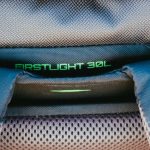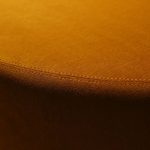When you choose Tetron fabric, you get a durable polyester-cotton blend that’s wrinkle-resistant, quick-drying, and comfortable against your skin. It resists shrinking and fading, making it ideal for uniforms, office wear, and home textiles. Tetron balances the strength of polyester with the softness and breathability of cotton, so you can enjoy both long-lasting use and easy care. Keep exploring to discover its full range of benefits and practical uses.
Table of Contents
Key Takeaways
- Tetron fabric is a blend of polyester and cotton fibers, combining durability with comfort.
- It resists wrinkles, shrinks less, and dries quickly, making it low-maintenance and practical.
- The fabric has a smooth texture that feels comfortable against the skin.
- Tetron maintains vibrant colors and resists static cling when properly dried.
- Its strength and wrinkle resistance make it ideal for uniforms, casual wear, and home textiles.
What Is Tetron Fabric?
Tetron fabric combines polyester and cotton fibers to create a durable and comfortable material. When you choose Tetron, you get the strength of polyester and the softness of cotton in one fabric.
This blend resists wrinkles, shrinks less, and dries quickly, making it practical for everyday use. You’ll find Tetron’s smooth texture pleasant against your skin, while its durability guarantees your clothes or upholstery last longer.
It’s often used in uniforms, casual wear, and home textiles because it balances comfort with easy maintenance. By blending these fibers, Tetron offers versatility—you don’t have to sacrifice comfort for resilience.
The History and Origin of Tetron
Blending polyester and cotton fibers didn’t happen overnight—it emerged from decades of textile innovation aimed at combining comfort with durability.
The fusion of polyester and cotton fibers evolved through years of innovation marrying comfort with resilience.
You’ll find that Tetron fabric’s roots trace back to the mid-20th century when manufacturers sought to improve traditional cotton fabrics by adding synthetic fibers. This blend offered better wrinkle resistance, strength, and ease of care.
When you choose Tetron, you’re benefiting from advancements made during the post-war boom in synthetic textiles. The name “Tetron” itself comes from a trademarked brand, popularized in Japan, reflecting a commitment to quality and innovation.
Understanding its history helps you appreciate how Tetron fabric became a practical solution for clothing that needed to balance softness with long-lasting wear.
Key Components of Tetron Fabric
Two main fibers make up Tetron fabric: polyester and cotton. When you combine these fibers, you get a blend that balances durability and comfort.
Polyester contributes strength, wrinkle resistance, and quick-drying properties, while cotton adds breathability and softness. This combination makes Tetron ideal for everyday wear.
You’ll find that the polyester in Tetron is usually derived from synthetic polymers, giving the fabric its resilience.
Cotton, sourced from natural fibers, provides moisture absorption and a natural feel against the skin. By blending these fibers, manufacturers create a fabric that resists shrinking and fading, yet remains comfortable to wear.
Understanding these components helps you appreciate why Tetron is popular in uniforms, casual clothing, and home textiles.
Physical Properties of Tetron
When you touch Tetron fabric, you’ll immediately notice its smooth texture and lightweight feel. This synthetic fiber blend combines polyester and cotton, giving Tetron excellent durability and resistance to wrinkles.
You’ll appreciate that it resists shrinking and stretching, maintaining its shape even after multiple washes. Tetron also boasts good breathability, so it’s comfortable to wear in various climates.
Its moisture-wicking properties help keep you dry by drawing sweat away from your skin. Additionally, Tetron resists stains and dries quickly, making it practical for everyday use.
You’ll find that it holds colors well, preventing fading over time. Overall, Tetron’s physical properties make it a reliable and low-maintenance fabric suitable for a range of needs.
Common Uses of Tetron Fabric
You’ll find Tetron fabric commonly used in apparel thanks to its durability and easy care.
It’s also popular in home textiles like curtains and upholstery for its strength and resistance to wrinkles.
Let’s explore how these qualities make Tetron a versatile choice in everyday items.
Apparel Applications
Tetron fabric suits a variety of apparel needs thanks to its durability and wrinkle resistance.
When you choose Tetron, you get clothes that hold their shape and look sharp even after long hours of wear. Its easy-care properties make it ideal for everyday and professional wardrobes.
You’ll find Tetron commonly used in:
- Uniforms for schools and workplaces, where durability matters
- Office wear like shirts and blouses that stay crisp without ironing
- Dresses and skirts that maintain their form and resist wrinkles
- Sportswear that benefits from its lightweight and breathable feel
Home Textile Uses
Beyond apparel, Tetron’s qualities make it a smart choice for home textiles as well.
You’ll find it widely used in curtains, upholstery, and bed linens because it’s durable, wrinkle-resistant, and easy to maintain.
When you choose Tetron for curtains, you benefit from its colorfastness and ability to block sunlight without fading over time.
For upholstery, Tetron’s strength and resistance to wear mean your furniture stays looking fresh longer.
In bedding, its softness and breathability guarantee comfort while keeping sheets crisp and wrinkle-free.
Plus, Tetron fabrics often resist stains, making them ideal for homes with kids or pets.
Advantages of Using Tetron
When you choose Tetron fabric, you get durability and strength that stand up to daily wear.
It’s also a smart choice if you want cost-effective materials without sacrificing quality.
Let’s explore why Tetron offers such great value for your needs.
Durability and Strength
Although you mightn’t notice it at first glance, the durability and strength of Tetron make it an excellent choice for various applications.
When you choose Tetron fabric, you’re getting material that stands up to wear and tear without losing shape or texture. Its resilience means it resists tearing, stretching, and abrasion, so your items last longer. You won’t have to worry about frequent replacements or repairs.
Here’s what you can expect from Tetron’s durability and strength:
- Strong fiber composition that withstands heavy use
- High resistance to stretching and deformation
- Superior abrasion resistance for rough handling
- Maintains structural integrity even after multiple washes
This makes Tetron ideal for clothing, upholstery, and industrial uses.
Cost-Effectiveness Benefits
Tetron’s strength and durability mean you won’t have to replace your items often, which saves you money in the long run.
Because Tetron resists wear and tear, your clothes, upholstery, or curtains last longer without fading or fraying. You’ll spend less on frequent replacements or repairs.
Additionally, Tetron requires minimal care—its wrinkle resistance means less ironing, so you save on energy and time. Its quick-drying nature also reduces laundering costs.
When you buy products made from Tetron, you’re investing in materials that balance quality with affordability, giving you great value.
Choosing Tetron helps you stretch your budget without sacrificing performance or appearance, making it an economical choice for everyday use.
How Tetron Compares to Other Fabrics
Since you’re choosing fabric for your next project, understanding how Tetron stacks up against other materials can help you make the best decision.
Tetron blends polyester and cotton, giving it unique advantages over pure fabrics. It offers durability and wrinkle resistance better than cotton alone. Compared to polyester, Tetron feels softer and more breathable, making it comfortable for daily wear.
It also tends to cost less than high-end natural fibers like silk or wool but performs well in strength and ease of care.
- More durable than 100% cotton, resisting wear and tear
- Softer and more breathable than pure polyester
- Less expensive than natural fibers like silk or wool
- Maintains shape and resists wrinkles better than many fabrics
This balance makes Tetron versatile for various uses.
Care and Maintenance Tips for Tetron
When you choose Tetron for your projects, knowing how to care for it properly guarantees it stays looking great longer.
Always wash Tetron in cold or lukewarm water to prevent shrinking and color fading. Use mild detergents and avoid bleach to maintain fabric integrity. You can machine wash Tetron on a gentle cycle, but avoid high spin speeds that might damage the fibers.
Wash Tetron gently in cold or lukewarm water with mild detergent to keep it vibrant and intact.
For drying, opt for air drying or tumble dry on low heat to prevent wrinkles and static cling. If ironing is needed, use a medium heat setting and iron while the fabric is slightly damp.
Store Tetron garments in a cool, dry place away from direct sunlight. Following these simple steps will keep your Tetron fabric durable, vibrant, and comfortable.
Environmental Impact and Sustainability of Tetron
Although Tetron offers durability and ease of care, you should consider its environmental impact before choosing it for your projects.
Tetron is a polyester blend, which means it relies on synthetic fibers derived from petroleum. This production process consumes significant energy and contributes to pollution. While Tetron lasts long, reducing frequent replacements, it’s not biodegradable and can release microplastics during washing.
If sustainability matters to you, weigh these factors carefully.
Here’s what you need to know about Tetron’s environmental impact:
- Made from non-renewable petroleum resources
- Energy-intensive manufacturing process
- Non-biodegradable, contributing to landfill waste
- Potential microplastic pollution during laundering
Understanding these points helps you make informed, eco-conscious choices with Tetron fabric.
Frequently Asked Questions
Can Tetron Fabric Be Recycled Into Other Products?
You can recycle Tetron fabric, but it depends on local facilities. Since it’s a polyester blend, recycling is possible into fibers for insulation or stuffing, but check if your area accepts this material to guarantee proper processing.
Is Tetron Fabric Hypoallergenic for Sensitive Skin?
About 20% of people experience allergic reactions to synthetic fabrics like Tetron. While it’s generally durable and wrinkle-resistant, Tetron isn’t always hypoallergenic, so you might want to test it if you have sensitive skin.
How Does Tetron Fabric React to Extreme Weather Conditions?
Tetron fabric handles extreme weather pretty well. It resists moisture and dries quickly, so you won’t feel soggy. However, in intense heat, it might trap some warmth, and in freezing cold, it offers limited insulation.
What Are Common Dyes Used for Tetron Fabric?
Oh, you’d think tetron’s synthetic nature would resist all dyes, but you’ll find disperse dyes work best. They bond well with its polyester fibers, giving you vibrant, lasting colors without fading in no time.
Can Tetron Fabric Be Blended With Natural Fibers?
Yes, you can blend Tetron fabric with natural fibers like cotton or wool. This blend enhances comfort and breathability while keeping Tetron’s durability, making your fabric versatile for various clothing and home textile applications.
- Tetron Fabric for Marine Applications: Durability and Use Cases - June 18, 2025
- Tetron Fabric for Outdoor Furniture: Weather Resistance and Care - June 18, 2025
- Tetron Fabric for Wall Coverings: Style and Application Tips - June 18, 2025







